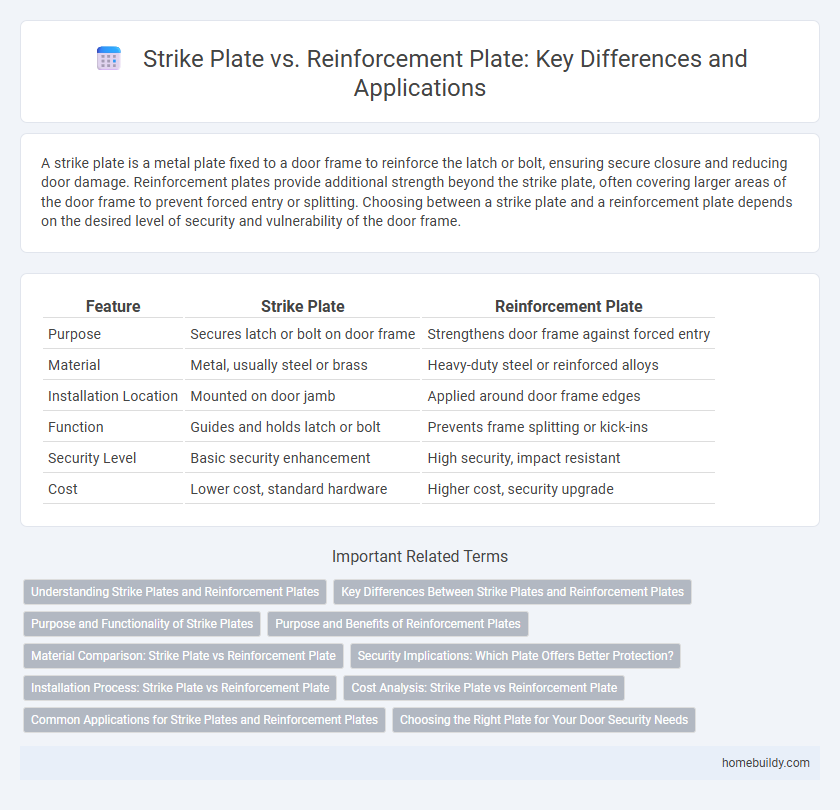A strike plate is a metal plate fixed to a door frame to reinforce the latch or bolt, ensuring secure closure and reducing door damage. Reinforcement plates provide additional strength beyond the strike plate, often covering larger areas of the door frame to prevent forced entry or splitting. Choosing between a strike plate and a reinforcement plate depends on the desired level of security and vulnerability of the door frame.
Table of Comparison
| Feature | Strike Plate | Reinforcement Plate |
|---|---|---|
| Purpose | Secures latch or bolt on door frame | Strengthens door frame against forced entry |
| Material | Metal, usually steel or brass | Heavy-duty steel or reinforced alloys |
| Installation Location | Mounted on door jamb | Applied around door frame edges |
| Function | Guides and holds latch or bolt | Prevents frame splitting or kick-ins |
| Security Level | Basic security enhancement | High security, impact resistant |
| Cost | Lower cost, standard hardware | Higher cost, security upgrade |
Understanding Strike Plates and Reinforcement Plates
Strike plates are metal components installed on door frames to catch the latch or bolt, ensuring the door locks securely. Reinforcement plates, often made from thicker or stronger materials, are designed to enhance the security of the strike plate area by distributing force and resisting forced entry. Understanding the differences between strike plates and reinforcement plates is crucial for optimizing door security and preventing break-ins.
Key Differences Between Strike Plates and Reinforcement Plates
Strike plates are metal components installed on door frames to receive and secure the latch or bolt, enhancing lock engagement and preventing door damage from repeated impact. Reinforcement plates extend beyond strike plates by providing additional structural strength to the door frame, helping resist forced entry and ensuring greater security in high-risk areas. The key difference lies in their function and application: strike plates primarily reinforce lock hardware while reinforcement plates strengthen the entire door frame for enhanced intrusion resistance.
Purpose and Functionality of Strike Plates
Strike plates serve as crucial components in door security by providing a reinforced surface for the latch or bolt to engage, enhancing resistance against forced entry. Unlike reinforcement plates that cover a larger area to strengthen the door frame, strike plates specifically protect the latch cavity, ensuring proper alignment and durability. Their primary function is to distribute the impact force from closing or forced entry attempts, reducing wear on the door frame and maintaining the integrity of the locking mechanism.
Purpose and Benefits of Reinforcement Plates
Reinforcement plates provide enhanced security by strengthening door frames beyond the capabilities of standard strike plates. They distribute the force from impacts or forced entry attempts more effectively, reducing the risk of frame splitting or warping. This added durability increases the longevity of the door assembly and improves overall resistance to break-ins.
Material Comparison: Strike Plate vs Reinforcement Plate
Strike plates are typically made from steel or brass, offering moderate strength and corrosion resistance for standard door security. Reinforcement plates, often constructed from heavy-gauge steel or stainless steel, provide superior durability and impact resistance, enhancing protection against forced entry. Choosing a reinforcement plate over a standard strike plate significantly increases the door's ability to withstand attacks due to its thicker, more robust materials.
Security Implications: Which Plate Offers Better Protection?
Strike plates and reinforcement plates both enhance door security, but reinforcement plates offer superior protection by strengthening the door frame against forced entry. Strike plates secure the latch or deadbolt to the frame, while reinforcement plates distribute impact force over a wider area, reducing vulnerability to kick-ins. Installing a high-quality steel reinforcement plate significantly improves resistance to break-ins compared to a standard strike plate alone.
Installation Process: Strike Plate vs Reinforcement Plate
Installing a strike plate involves aligning it with the door frame's latch hole and securing it with screws, typically requiring minimal modification. In contrast, installing a reinforcement plate demands more extensive preparation, including chiseling or drilling to fit the thicker metal and additional screws for enhanced security. Reinforcement plates often require professional installation to ensure proper alignment and maximum protection against forced entry.
Cost Analysis: Strike Plate vs Reinforcement Plate
Strike plates typically cost between $5 and $15, offering an affordable solution for standard door security by distributing the force of a latch or bolt into the door frame. Reinforcement plates, priced from $20 to $50, provide enhanced protection by strengthening the door frame and resisting forced entry, making them a cost-effective investment for high-security needs. When analyzing cost-effectiveness, strike plates suit moderate security requirements, while reinforcement plates deliver superior durability and protection at a higher upfront expense.
Common Applications for Strike Plates and Reinforcement Plates
Strike plates are commonly used in residential doors to receive the latch or bolt, enhancing door security and alignment by distributing the force applied during closing. Reinforcement plates are typically installed around locksets and deadbolts in commercial or high-security doors, providing added strength against forced entry and preventing door frame damage. Both components are essential in securing door hardware, with strike plates suited for standard applications and reinforcement plates for enhanced protection where higher security demands exist.
Choosing the Right Plate for Your Door Security Needs
Strike plates provide essential reinforcement for door frames by securing the latch or bolt, ensuring proper alignment and resistance against forced entry. Reinforcement plates extend protection by strengthening the entire door frame area around the strike plate, ideal for high-security needs and doors exposed to heavy impact. Selecting between a standard strike plate and a reinforcement plate depends on factors such as door material, security requirements, and installation environment, with reinforcement plates best suited for areas demanding enhanced protection.
strike plate vs reinforcement plate Infographic

 homebuildy.com
homebuildy.com